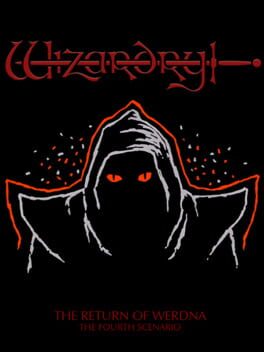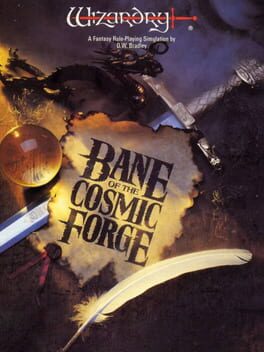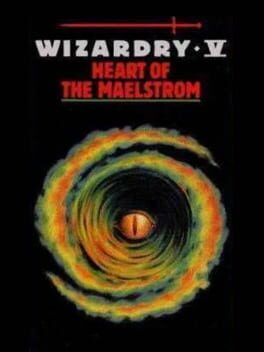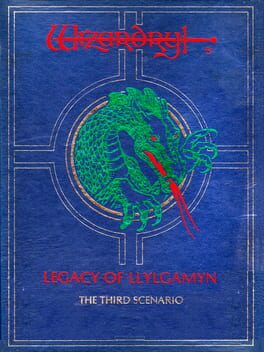

Wizardry: The Return of Werdna - The Fourth Scenario
The fourth game in the Wizardry series, The Return of Werdna takes a decidedly different approach from all the games that preceded it. Instead of playing as a party of six player-generated characters, the player controls Werdna himself, the evil Archmage from the first game. It seems that after Werdna was defeated by the party of adventurers who stole his amulet, he was imprisoned at the bottom of his ten-level labyrinth in an eternal slumber to be tortured by nightmares for eternity. Although Werdna was supposed to sleep forever, somehow he has awakened, and now he is out for revenge. At the beginning of the game Werdna finds himself in a situation that is singularly unique for most arch-villains: he is stripped of his powers, trapped within his own former stronghold, and filled with the realization that the same traps and monsters he created to keep adventurers out now act as obstacles to his freedom. Werdna will slowly regain his magical powers as well as have the ability to summon helpful monsters to accompany him on his journey and aid him in combat. Unlike other role-playing games, no experience is awarded for defeating enemies. Instead, Werdna can only become stronger by searching for pentagrams found in the labyrinth. Accessing a new pentagram allows Werdna to summon stronger monsters and restore his health and spellcasting powers. Werdna will have to fight a variety of monsters and guardians, but many of the randomly appearing enemies in the game are parties of adventurers not unlike those who were controlled by the player in the previous three games. In addition, Werdna is being chased by the rather ticked-off ghost of his old enemy Trebor. The game features a somewhat tweaked version of the same engine and graphics used in the earlier installments of the series. The difficulty level has been increased due to the lack of an experience points system, which often leaves the player-controlled party underpowered. The labyrinth contains abundant traps and complex mazes. For obvious reasons it is no longer possible to import characters from the previous games. The game features three different endings: a good ending, an evil ending, and a special Grandmaster ending which is often considered to be the single most difficult task to achieve in the entire series.
Also in series
Reviews View More
This game was basically designed for Wizardry masochists in the first place, so if you approach it from that mindset, it's brilliant in a sadistic way. The concept of turning the original game upside down and playing as a defeated Werdna is cool. The monster catching is a novel gameplay mechanic, and even the struggle to make it out of the dungeon has a certain allure to it. Some of the NPCs are even named after player's characters who sent their saved character disks to the developer.
It's sort of like the extended cut of David Lynch's Dune. I would only recommend it to the diehard fans, because they would appreciate the audacity, despite the flaws.
This is honestly one of the nuttiest and sadistic games i've played. The game has you playing as final boss of the original wizardry 1 escaping a dungeon after your defeat. Not only does it offer a refreshing narrative of being able to play as piece of shit mowing down hundreds do gooder heroes trying to stop you but the gameplay works so well with this. Its basically a complete reversal of the gameplay of wiz1-3 as you get the ability to summon nearly every single enemy found in those games to fight alongside you against regular teams of fighters, mages, priests etc even the ui was flipped to fit the theme of playing as the bad guys. summoning enemies is also satisfying as you recognise a lot of the op enemies that gave you trouble in wiz 1-3 and there just as broken on your side, like wise a lot of the op spells you used are now used against you. The overall story is just really fun getting to see werdnas inner thoughts and fighting all of the different self-righteous groups that are trying to kill you.
A lot of the issues people have with this game come from it being more of a puzzle game than an rpg, a lot of the gameplay is just exploring the dungeon, finding key items and secret areas. Battles dont give xp so they only exist to slow you down or sometimes give you items you need. Overall the puzzles aren't too bad until you get to the last 2 areas which are filled with difficult labyrinthian dungeons and incredibly obtuse puzzles that require very specific knowledge of earlier games and pop culture references that realistically you wont have the answer to and if you don't have one answer to a puzzle you just cant beat the game. Even with all these frustrating puzzles the final area is so awesome and the overall experience of the game is so unique that I came out of the game loving it.
I understand why it did but im still sad that this game sold poorly and is probably one of the reasons as to why the series is in such a rut today
Sure. It’s hell. But it’s calculated hell; cunning in all the right ways; wildly eccentric when it sees fit. Supported by its transformative scenario design, there was nothing else this unusual. Roe R Adams had assisted Ultima 4 on a spiritual revolution, defining RPGs as more than mere numbers and combat, using the journey as a basis for moral exploration. The result of his work on Wizardry 4 was the audacious inversion of roles, with not only narrative implication but fundamental change to design. We are ascending; we occupy the top row of the battle screen while the “heroes”' are on the bottom (like every other RPG); we fight with hordes of summoned monsters; and we have a choice of salvation or continued chaos on the surface. How rare was it to have a massive, pre-defined set of party members to choose from, let alone your foes who drove you mad in the first three scenarios. The kicker? If you sent your characters from the original scenarios to Sir-Tech, they would appear as wandering enemies for Werdna to fight. Yes, your battles are against the real adventuring parties of past players.
There are five, wholly unique endings in this game, going beyond the traditional dichotomy of good or evil. All of this is running on the stock 64KB Apple II. These were the days when a bevy of sequels to established franchises were showing up and developers were truly eager to break new ground. Wizardry 4’s mission is clear, in that it's firmly designed for experienced players, but has an imbued sense of moral-purpose backing its foundation. The expression is defined through the challenge of genre convention — and there was perhaps no one more qualified for the task than Werdna, the first iconic RPG villain, who would smite you down without fail in the original game.
(Note: I won’t cover in depth that this was the first game to feature a monster party, a highly original (and controversial) concept for its development time. Megami Tensei did come out the same year, nor do I particularly care for firsts, and prefer to think of game design as a conceptual pool that many draw from).
Much like Wizardry 1, the main enemy of the game is the labyrinthine dungeon, fervently zapping away at your resources. Instead of plunging into the darkness and returning to town for purified air, we must navigate our god-given morbid imprisonment as a means of respite. Said respite is found through the pentagram system (think of these as safe-rooms), but you are either being flanked by hero groups or the mad king, who never ceases chase, moving in real-time (even during idle) and will kill you instantly if found. Can you make it to the next safe-room? The clock is always ticking. The dynamic is that the hero groups will play by your traditional map rules, but the mad king can usurp you at any time, forgoing the board entirely. Staying idle is not an option; it’s a game of continuous movement and tense decision making. We hang on to every last spell. Summoned monsters are your weaponry, but they drop like flies and are prone to fleeing at the hint of resistance. Wandering hero groups fight you as if it’s their last battle. In their world; we are the final boss; and are accordingly shown no remorse. These enemy-types stay permanently dead until you save. Saving resets the mad king's position completely, making him non-threatening. (I will mention to be clear, you can save anywhere in this game, any square, safe or not. And you have enough time to explore, but just enough “push” that it’s imperative to stay moving). Which reprieve will you choose?
This well-crafted risk/reward dilemma places players in a constant state of tension, weighing the need for exploration (further knowledge), the quest for vital resources (spells and items), and the imperative for acute survival — by either rendering enemies dead (don’t save) or ending the mad king’s relentless pursuit (choose to save). This follows the design idea of a tactical-puzzle, in which each floor become a devout ritual of manic exploration and planned resources, in a lead to find the next safe-room. The pentagram is safe from all hostile forces and doubles as a utility hub for resources, such as a rotating cast of monsters and leveling up. Monsters act as the pragmatic puzzle pieces that fit the design as one. Finding out how they work for the situation at hand is paramount to survival, and knowledge of the previous three scenarios is rather valuable, if not essential. Like an enigma being constantly unraveled, the game sees fit to evolve, with monsters and riddles being in constant flux, changing every pentagram. The goal is to fully regain your powers, and believe me, there is no greater satisfaction than when you can finally teleport throughout the entire dungeon and blast the hero scum to smithereens with great demons at your side. The last barrier standing between you and freedom is the Cosmic Cube. If every previous floor has been a delicate challenge of abstract mapping concepts, this is the test that questions how attentive you’ve really been, by bringing all learned principles to the forefront and merging three floors into a quasi-connected "3D" level. (For anyone unfamiliar: Picture a simple 20x20 square grid. A 3D dungeon adds a third coordinate into the mix, meaning you get 20x20x3 and account for a multi-layered map that functions as one with ladders and teleports. A number of paths can reach the exit — making it a highly unique and non-linear puzzle).
By the end, the dungeon presents itself as a large-scale puzzle to solve, and you are able to find an item that sends the mad king to the permanent void, taking him out of the equation entirely. The game does all of this with a clear sense of intention. Playable inferno sure, but a truly bewitching uniqueness that few games can replicate.
Sweet Home rings closest to the design, in that it may have the outer layer of an RPG, but discerning the maze-like structure is more vital than any amount of leveling. Strategic planning is a requirement, with power being incrementally given through the pentagram system and items that play as a finite resource. Grinding is not possible (it is in Sweet Home to be fair, but caps early, and battles are risky, if you die that character is gone for good), so the design is deliberate, to be mapped and solved. Brute forcing your way through the game is far-fetched notion. Our understanding of these games is rather similar. They end up being known for only one thing (decomposing as banal trivia), instead of being assessed on their own terms, as a tense fusion of adventure and RPG design. It may be better described as a true survival RPG — and the game imparts this all too well with layered hostility that never quite settles.
There is an unfounded notion that Wizardry 4 is the hardest game ever made, brutally unfair, as if it can only be one thing. This serves to only strip away the creative authorship of the designer, in which we choose to solely engage with a loaded-definition. At that point, are we actively engaging with the design, or a vague notion of what we think the work should be? (Yes, you’ve seen this before, for a game or any artistic medium). Look. Wizardry 4 is a difficult game. But it isn’t the hardest game ever made; or even atypical of its era, that forged a path on a particular quality of play. The right to win was to be earned — not merely given away as an unequal transaction. Death was a rite of passage that tied together the designer’s ability to communicate game structure and understanding. This isn’t to downplay the challenge, but illustrate that it comes from a place of purposeful intent. The game in actuality is supremely balanced, juggling mechanical complexity on a floor-by-floor basis, and fair for a keen player who is willing to parse it’s deep-rooted design langauge. (That said, the thieves that constantly steal your key-items and run are extremely annoying. This I would have minimized, the only thing in the game I would outright change).
The myth of the first room is quite frankly, bullshit. For reference, you begin the game in a 2x2 dark room with a lone pentagram at your side and a hidden door on the wall. Now, think how unconventional the monster system was, how this room provides a completely safe environment, and teaches us about a secret-heavy game. Even more, the game relies on monster usage relating to the floor at hand, which is also taught here. By getting out of here: We know about secrets, we’ve understood how monsters function in a safe environment, and we’ve learned the importance of pentagrams. This is silent game design, routine for the time, and a rather good bout at that. But you need a priest, right?. Oh dear. Werdna is completely powerless. He is a sitting duck in the bowels of hell. Anyone who has played an RPG for 30 minutes knows that you need a healer on your team. This simple puzzle now ties logic into its teaching exercise and sets the tone for the game accordingly. Right away, we are given the baseline understanding to succeed – all with zero risk of death. Metroid and Dragon Quest 1 both start in a similar manner with a resistant-problem (morph ball and command system, respectively). Presenting friction to the player that allows them to learn the langauge. Funny enough, a sealed envelope was included with the game dubbed “solution to the first puzzle” that mocked anyone who couldn’t get past it and told them to give up, because the real challenge was coming. The most beautiful words an 80’s nerd can hear.
Sir-Tech succeeded tremendously well at the inversion of what a dungeon crawler could be: Taking skill check out of the equation with a dynamic risk/reward scheme and relying on expert-level logic as its preeminent philosophy. The inventive scenario design only served to further the goal, running contrary to all RPGs. It stands alone as this high-concept performance piece — made by the inmates for the asylum — read in silence as a maddening love letter to our earliest roots of gaming. In that sense, Wizardry 4 marks the end of the PLATO lineage. A long lost embodiment of what one culture thought interactive software should be. They don’t make em’ like this anymore. Even attempting so would be futile.
Criminally misunderstood is my verdict. One that paints a stark contrast of ideas; out of the dungeon and into the light. A question of faith that must be earned, through the form of perilous redemption under deafening opposition. It took me over half a year to finish, toiling away at its secrets. At the end of it all, it really does feel like you have climbed the darkest mountain to salvation. I respect the hell out of this game. Video games do not dare to go here again.





